Soil Quality Evaluation for Cotton Fields in Arid Region Based on Graph Convolution Network
Abstract
:1. Introduction
2. Materials and Methods
2.1. Study Site
2.2. Sampling and Chemical Determination
2.3. Soil Quality Evaluation Criteria
2.3.1. Statistical Analysis
2.3.2. Correlation Analysis
2.3.3. Analysis of Soil Spatial Variation
2.4. Soil Quality Evaluation Methods
2.4.1. Soil Quality Index (SQI)
2.4.2. GCN
2.4.3. Modeling and Evaluation
3. Results
3.1. Statistical Analysis of the Values of Soil Quality Evaluation Indices
3.2. Correlation Analysis of Soil Evaluation Indices
3.3. Spatial Variation of Soil Samples of Different Grades
3.4. SQI Evaluation
3.5. GCN Model Evaluation
4. Discussion
4.1. Analysis of Soil Quality Evaluation Indices
4.2. Spatial Distribution Characteristics of Soils of Different Grades
4.3. Soil Quality Evaluation Based on GCN Model
5. Conclusions
Author Contributions
Funding
Data Availability Statement
Conflicts of Interest
References
- Mi, W.; Sun, T.; Ma, Y.; Chen, C.; Ma, Q.; Wu, L.; Wu, Q.; Xu, Q. Higher Yield Sustainability and Soil Quality by Manure Amendment than Straw Returning under a Single-Rice Cropping System. Field Crop. Res. 2023, 292, 108805. [Google Scholar] [CrossRef]
- Kurmangozhinov, A.; Xue, W.; Li, X.; Zeng, F.; Sabit, R.; Tusun, T. High biomass production with abundant leaf litterfall is critical to ameliorating soil quality and productivity in reclaimed sandy desertification land. J. Environ. Manag. 2020, 263, 110373. [Google Scholar] [CrossRef] [PubMed]
- Liu, X.; Meng, L.; Yin, T.; Wang, X.; Zhang, S.; Cheng, Z.; Ogundeji, A.O.; Li, S. Maize/soybean intercrop over time has higher yield stability relative to matched monoculture under different nitrogen-application rates. Field Crop. Res. 2023, 301, 109015. [Google Scholar] [CrossRef]
- Lowe, M.-A.; Mathes, F.; Loke, M.H.; McGrath, G.; Murphy, D.V.; Leopold, M. Bacillus Subtilis and Surfactant Amendments for the Breakdown of Soil Water Repellency in a Sandy Soil. Geoderma 2019, 344, 108–118. [Google Scholar] [CrossRef]
- Zheng, L.; Jiang, C.; Chen, X.; Li, Y.; Li, C.; Zheng, L. Combining hydrochemistry and hydrogen and oxygen stable isotopes to reveal the influence of human activities on surface water quality in Chaohu Lake Basin. J. Environ. Manag. 2022, 312, 114933. [Google Scholar] [CrossRef]
- Santos-Francés, F.; Martínez-Graña, A.; Ávila-Zarza, C.; Criado, M.; Sánchez, Y. Comparison of methods for evaluating soil quality of semiarid ecosystem and evaluation of the effects of physico-chemical properties and factor soil erodibility (Northern Plateau, Spain). Geoderma 2019, 354, 113872. [Google Scholar] [CrossRef]
- Wang, Z.; Jin, M.; Šimůnek, J.; van Genuchten, M.T. Evaluation of mulched drip irrigation for cotton in arid Northwest China. Irrig. Sci. 2014, 32, 15–27. [Google Scholar] [CrossRef]
- Han, C.; Zheng, J.; Guan, J.; Yu, D.; Lu, B. Evaluating and Simulating Resource and Environmental Carrying Capacity in Arid and Semiarid Regions: A Case Study of Xinjiang, China. J. Clean. Prod. 2022, 338, 130646. [Google Scholar] [CrossRef]
- Wu, C.; Liu, G.; Huang, C.; Liu, Q. Soil quality assessment in Yellow River Delta: Establishing a minimum data set and fuzzy logic model. Geoderma 2019, 334, 82–89. [Google Scholar] [CrossRef]
- Han, Z.G.; Chen, H.; Cao, Y.W.; He, L.; Si, Z.F.; Hu, Y.; Lin, H.; Ning, X.Z.; Li, Q.M.; Liu, F.J.; et al. Genomic insights into genetic improvement of upland cotton in the world’s largest growing region. Ind. Crop. Prod. 2022, 183, 114929. [Google Scholar] [CrossRef]
- Li, C.B.; Xiao, K.Y.; Li, N.; Song, X.L.; Zhang, S.; Wang, K.; Chu, W.K.; Cao, R. A comparative study of support vector machine, random forest and artificial neural network machine learning algorithms in geochemical anomaly information extraction. Acta Geosci. Sinica. 2020, 2, 309–319, (In Chinese with English Abstract). [Google Scholar] [CrossRef]
- Essa, F.A.; Elaziz, M.A.; Elsheikh, A.H. An enhanced productivity prediction model of active solar still using artificial neural network and Harris Hawks optimizer. Appl. Therm. Eng. 2020, 170, 115020. [Google Scholar] [CrossRef]
- Zhang, D.Y.; Zhang, W.; Huang, W.; Hong, Z.M.; Meng, L.K. Upscaling of surface soil moisture using a deep learning model with VIIRS RDR. ISPRS. Int. J. Geo-Inf. 2017, 6, 130. [Google Scholar] [CrossRef]
- Bruna, J.; Zaremba, W.; Szlam, A.; Le, C.Y. Spectral networks and locally connected networks on graphs. arXiv 2014, arXiv:1312.6203. [Google Scholar] [CrossRef]
- Fukunaga, I.; Sawada, R.; Shibata, T.; Kaitoh, K.; Sakai, Y.; Yamanishi, Y. Prediction of the health effects of food peptides and elucidation of the mode-ofaction using multi-task graph convolutional neural network. Mol. Inform. 2020, 39, 1900134. [Google Scholar] [CrossRef]
- Ramirez, R.; Chiu, Y.C.; Hererra, A.; Mostavi, M.; Ramirez, J.; Chen, Y.; Huang, Y.; Jin, Y.F. Classification of Cancer Types Using Graph Convolutional Neural Networks. Front. Phys. 2020, 8, 203. [Google Scholar] [CrossRef]
- Zhou, J.; Cui, G.; Hu, S.; Zhang, Z.; Yang, C.; Liu, Z.; Wang, L.; Li, C.; Sun, M. Graph neural networks: A review of methods and applications. AI Open 2020, 1, 57–81. [Google Scholar] [CrossRef]
- Wu, Z.; Chen, H.; Zhang, J.; Liu, S.; Huang, R.; Pei, Y. A directed link prediction method using graph convolutional network based on social ranking theory. Intell. Data Anal. 2021, 25, 739–757. [Google Scholar] [CrossRef]
- Wu, Z.; Pan, S.; Chen, F.; Long, G.; Zhang, C.; Yu, P.S. A Comprehensive Survey on Graph Neural Networks. IEEE Trans. Neural Netw. Learn. Syst. 2021, 32, 4–24. [Google Scholar] [CrossRef]
- Zhao, D.; Wang, J.; Lin, H.; Yang, Z.; Zhang, Y. Extracting drug–drug interactions with hybrid bidirectional gated recurrent unit and graph convolutional network. J. Biomed. Inform. 2019, 99, 103295. [Google Scholar] [CrossRef]
- Shi, J.; Wang, R.; Zheng, Y.; Jiang, Z.; Yu, L. Cervical cell classification with graph convolutional network. Comput. Meth. Prog. Bio. 2021, 198, 105807. [Google Scholar] [CrossRef] [PubMed]
- Bin, Y.; Chen, Z.M.; Wei, X.S.; Chen, X.; Gao, C.; Sang, N. Structure-aware human pose estimation with graph convolutional networks. Pattern Recognit. 2020, 106, 107410. [Google Scholar] [CrossRef]
- Zhao, G.; He, H.; Huang, Y.; Ren, J. Near-surface PM2.5 prediction combining the complex network characterization and graph convolution neural network. Neural Comput. Appl. 2021, 33, 17081–17101. [Google Scholar] [CrossRef]
- Abdel-Fattah, M.K.; Mohamed, E.S.; Wagdi, E.M.; Shahin, S.A.; Aldosari, A.A.; Lasaponara, R.; Alnaimy, M.A. Quantitative Evaluation of Soil Quality Using Principal Component Analysis: The Case Study of El-Fayoum Depression Egypt. Sustainability-basel. 2021, 13, 1824. [Google Scholar] [CrossRef]
- Qin, S.; Xu, Y.; Liu, H.; Li, C.; Yang, Y.; Zhao, P. Effect of different boron levels on yield and nutrient content of wheat based on grey relational degree analysis. Acta Physiol. Plant 2021, 43, 127. [Google Scholar] [CrossRef]
- Peng, M.; He, H.; Wang, Z.; Li, G.; Lv, X.; Pu, X.; Zhuang, L. Responses and comprehensive evaluation of growth characteristics of ephemeral plants in the desert–oasis ecotone to soil types. J. Environ. Manag. 2022, 316, 115288. [Google Scholar] [CrossRef]
- Huang, Y.; Chen, Q.; Deng, M.; Japenga, J.; Li, T.; Yang, X.; He, Z. Heavy metal pollution and health risk assessment of agricultural soils in a typical peri-urban area in southeast China. J. Environ. Manag. 2018, 207, 159–168. [Google Scholar] [CrossRef]
- Sharma, K.; Janardhana Raju, N.; Singh, N.; Sreekesh, S. Heavy metal pollution in groundwater of urban Delhi environs: Pollution indices and health risk assessment. Urban Clim. 2022, 45, 101233. [Google Scholar] [CrossRef]
- Della Chiesa, S.; La Cecilia, D.; Genova, G.; Balotti, A.; Thalheimer, M.; Tappeiner, U.; Niedrist, G. Farmers as data sources: Cooperative framework for mapping soil properties for permanent crops in South Tyrol (Northern Italy). Geoderma 2019, 342, 93–105. [Google Scholar]
- Lei, K.; Li, Y.; Zhang, Y.; Wang, S.; Yu, E.; Li, F.; Xiao, F.; Xia, F. Development of a New Method Framework to Estimate the Nonlinear and Interaction Relationship between Environmental Factors and Soil Heavy Metals. Sci. Total. Environ. 2023, 905, 167133. [Google Scholar] [CrossRef]
- Li, C.M.; Ma, Y.Z.; Xu, W.X.; Wang, F.; Li, P.C.; Li, L.; Fang, Y.F.; Zhang, N. Effects of different nitrogen application rates on cotton yield and soil nutrients in cotton fields. J. Agr. Sci. 2022, 36, 1446–1455. [Google Scholar] [CrossRef]
- Wang, J.; Peng, J.; Li, H.; Yin, C.; Liu, W.; Wang, T.; Zhang, H. Soil Salinity Mapping Using Machine Learning Algorithms with the Sentinel-2 MSI in Arid Areas, China. Remote Sens. 2021, 13, 305. [Google Scholar] [CrossRef]
- Scudiero, E.; Skaggs, T.H.; Corwin, D.L. Simplifying field-scale assessment of spatiotemporal changes of soil salinity. Sci. Total. Environ. 2017, 587, 273–281. [Google Scholar] [CrossRef] [PubMed]
- Bao, S.D. Soil Agrochemical Analysis; China Agricultural Press: Beijing, China, 2000; p. 1. [Google Scholar]
- Zhang, F.S. Essentials of Soil Testing and Formula Fertilization Technology; China Agricultural University Press: Beijing, China, 2006. [Google Scholar]
- Zheng, Q. Comprehensive Evaluation of Soil Environmental Quality of Cotton Field in Xinjiang Oasis. Master’s Thesis, Shihezi University, Shihezi, China, 2018. [Google Scholar] [CrossRef]
- Bermudez-Edo, M.; Barnaghi, P.; Moessner, K. Analysing real world data streams with spatio-temporal correlations: Entropy vs. Pearson correlation. Autom. Constr. 2018, 88, 87–100. [Google Scholar] [CrossRef]
- Li, Z. An enhanced dual IDW method for high-quality geospatial interpolation. Sci. Rep. 2021, 11, 9903–9917. [Google Scholar] [CrossRef]
- Oliveira, J.A.J.D.; Souza, S.R.L.D.; Dal, P.E.; Rodrigues, B.T.; Souza, V.C.D. Aurora: Mobile application for analysis of spatial variability of thermal comfort indexes of animals and people, using IDW interpolation. Comput. Electron. Agr. 2019, 157, 98–101. [Google Scholar] [CrossRef]
- Zeraatpisheh, M.; Bakhshandeh, E.; Hosseini, M.; Alavi, S.M. Assessing the effects of deforestation and intensive agriculture on the soil quality through digital soil mapping. Geoderma 2020, 363, 114139. [Google Scholar] [CrossRef]
- Wen, X.; Hong, M.; Zhang, Y.X.; Pei, Z.F.; Zhao, H.X.; Chen, C. Effects of organic materials addition on the organic carbon pool and soil quality of alkalized soil. Chin. J. Grassl. 2022, 44, 39–49. [Google Scholar] [CrossRef]
- Yu, B.; Lee, Y.; Sohn, K. Forecasting road traffic speeds by considering area-wide spatio-temporal dependencies based on a graph convolutional neural network (GCN). Transp. Res Part C-Emer. 2020, 114, 189–204. [Google Scholar] [CrossRef]
- Song, Y.; Lu, S.; Qiu, D. Improving Node Classification through Convolutional Networks Built on Enhanced Message-Passing Graph. Comput. Intel. Neurosc. 2022, 2022, e3999144. [Google Scholar] [CrossRef]
- Pang, P.S.; Hou, X.; Xia, L. Borrowers’ credit quality scoring model and applications, with default discriminant analysis based on the extreme learning machine. Technol. Forecast. Soc. 2021, 165, 120462. [Google Scholar] [CrossRef]
- Liu, X.H.; Bai, Y.G.; Chai, Z.P.; Zhang, J.H.; Jiang, Z.; Ding, B.X.; Zhang, C. Multispectral remote sensing inversion and seasonal difference in soil salinity of cotton field in typical oasis irrigation area. J. Agric. Resour. Environ. 2023, 40, 598–609. [Google Scholar]
- Wei, X.; Huang, S.; Huang, Q.; Liu, D.; Leng, G.; Yang, H.; Duan, W.; Li, J.; Bai, Q.; Peng, J. Analysis of Vegetation Vulnerability Dynamics and Driving Forces to Multiple Drought Stresses in a Changing Environment. Remote Sens. 2022, 14, 4231. [Google Scholar] [CrossRef]
- Zhu, S.; Lei, Y.; Wang, C.; Wei, Y.; Wang, C.; Sun, Y. Patterns of yeast diversity distribution and its drivers in rhizosphere soil of Hami melon orchards in different regions of Xinjiang. BMC Microbiol. 2021, 21, 170. [Google Scholar] [CrossRef]
- Wei, G.Y. Ecological Changes and Possible Mechanisms of Alpine-Oasis Lakes in the Arid Region of Northwest China in the Past Two Thousands of Years. Master’s Thesis, Lanzhou University, Lanzhou, China, 2018. [Google Scholar]
- Wen, X.; Lu, J.; Wu, J.; Lin, Y.; Luo, Y. Influence of coastal groundwater salinization on the distribution and risks of heavy metals. Sci. Total. Environ. 2019, 652, 267–277. [Google Scholar] [CrossRef]
- Niu, F.P.; Li, X.G.; Jin, W.G.; Mai, M.T.T.R.X.E.Z.Z. Characteristics of soil salinity in the western lakeside oasis of Bosten Lake. Soil. Fertil. Sci. China 2020, 3, 8–15. [Google Scholar] [CrossRef]
- Yu, Y.; Zhao, C.; Zheng, N.; Jia, H.; Yao, H. Interactive effects of soil texture and salinity on nitrous oxide emissions following crop residue amendment. Geoderma 2019, 337, 1146–1154. [Google Scholar] [CrossRef]
- Che, Z.; Wang, J.; Li, J. Determination of threshold soil salinity with consideration of salinity stress alleviation by applying nitrogen in the arid region. Irrig. Sci. 2022, 40, 283–296. [Google Scholar] [CrossRef]
- Surendran, U.; Madhava, C.K. Development and evaluation of drip irrigation and fertigation scheduling to improve water productivity and sustainable crop production using HYDRUS. Agr. Water Manag. 2022, 269, 107668. [Google Scholar] [CrossRef]
- Mamat, Z.; Haximu, S.; Zhang, Z.Y.; Aji, R. An ecological risk assessment of heavy metal contamination in the surface sediments of Bosten Lake, northwest China. Environ. Sci. Pollut. Res. 2016, 23, 7255–7265. [Google Scholar] [CrossRef]
- Chen, L.; Wei, Q.; Xu, G.; Wei, M.; Chen, H. Contamination and Ecological Risk Assessment of Heavy Metals in Surface Sediments of Huangshui River, Northwest China. J. Chem. 2022, 2022, e4282992. [Google Scholar] [CrossRef]
- Wu, L.; Yue, W.; Zheng, N.; Guo, M.; Teng, Y. Assessing the impact of different salinities on the desorption of Cd, Cu and Zn in soils with combined pollution. Sci. Total. Environ. 2022, 836, 155725. [Google Scholar] [CrossRef] [PubMed]
- Calzolari, C.; Ungaro, F.; Vacca, A. Effectiveness of a soil mapping geomatic approach to predict the spatial distribution of soil types and their properties. Catena 2021, 196, 104818. [Google Scholar] [CrossRef]
- Akana, P.R.; Bateman, J.B.; Vitousek, P.M. Water balance affects foliar and soil nutrients differently. Oecologia 2022, 199, 965–977. [Google Scholar] [CrossRef] [PubMed]
- Shi, Y.; Zhang, K.; Li, Q.; Liu, X.; He, J.-S.; Chu, H. Interannual climate variability and altered precipitation influence the soil microbial community structure in a Tibetan Plateau grassland. Sci. Total Environ. 2020, 714, 136794. [Google Scholar] [CrossRef]
- Wen, Y.L.; Guo, X.Y.; Cheng, L.; Yu, G.H.; Xiao, J.; He, X.H.; Goodman, B.A. Organic amendments stimulate co-precipitation of ferrihydrite and dissolved organic matter in soils. Geoderma 2021, 402, 115352. [Google Scholar] [CrossRef]
- Xia, S.; Song, Z.; Li, Q.; Guo, L.; Yu, C.; Singh, B.P.; Fu, X.; Chen, C.; Wang, Y.; Wang, H. Distribution, sources, and decomposition of soil organic matter along a salinity gradient in estuarine wetlands characterized by C:N ratio, δ13C-δ15N, and lignin biomarker. Global Chang. Biol. 2021, 27, 417–434. [Google Scholar] [CrossRef]
- Świdwa-Urbańska, J.; Batlle-Sales, J. Data quality oriented procedure, for detailed mapping of heavy metals in urban topsoil as an approach to human health risk assessment. J. Environ. Manag. 2021, 295, 113019. [Google Scholar] [CrossRef]
- Alnaimy, M.A.; Shahin, S.A.; Vranayova, Z.; Zelenakova, M.; Abdel-Hamed, E.M.W. Long-Term Impact of Wastewater Irrigation on Soil Pollution and Degradation: A Case Study from Egypt. Water 2021, 13, 2245. [Google Scholar] [CrossRef]
- Manoj, S.R.; Karthik, C.; Kadirvelu, K.; Arulselvi, P.I.; Shanmugasundaram, T.; Bruno, B.; Rajkumar, M. Understanding the molecular mechanisms for the enhanced phytoremediation of heavy metals through plant growth promoting rhizobacteria: A review. J. Environ. Manag. 2020, 254, 109779. [Google Scholar] [CrossRef]
- Chen, Y.; Fu, X.; Liu, Y. Effect of farmland scale on farmers’ application behavior with organic fertilizer. Int. J. Environ. Res. Public Health 2022, 19, 4967. [Google Scholar] [CrossRef] [PubMed]
- Alnaimy, M.A.; Elrys, A.S.; Zelenakova, M.; Pietrucha-Urbanik, K.; Merwad, A.-R.M. The Vital Roles of Parent Material in Driving Soil Substrates and Heavy Metals Availability in Arid Alkaline Regions: A Case Study from Egypt. Water 2023, 15, 2481. [Google Scholar] [CrossRef]
- Guan, Q.; Zhao, R.; Wang, F.; Pan, N.; Yang, L.; Song, N.; Xu, C.; Lin, J. Prediction of heavy metals in soils of an arid area based on multi-spectral data. J. Environ. Manag. 2019, 243, 137–143. [Google Scholar] [CrossRef]
- Liao, Y.; Cao, H.X.; Liu, X.; Li, H.T.; Hu, Q.Y.; Xue, W.K. By increasing infiltration and reducing evaporation, mulching can improve the soil water environment and apple yield of orchards in semiarid areas. Agric. Water Manag. 2021, 253, 106936. [Google Scholar] [CrossRef]
- Fei, X.; Xiao, R.; Christakos, G.; Langousis, A.; Ren, Z.; Tian, Y.; Lv, X. Comprehensive assessment and source apportionment of heavy metals in Shanghai agricultural soils with different fertility levels. Ecol. Indic. 2019, 106, 105508. [Google Scholar] [CrossRef]
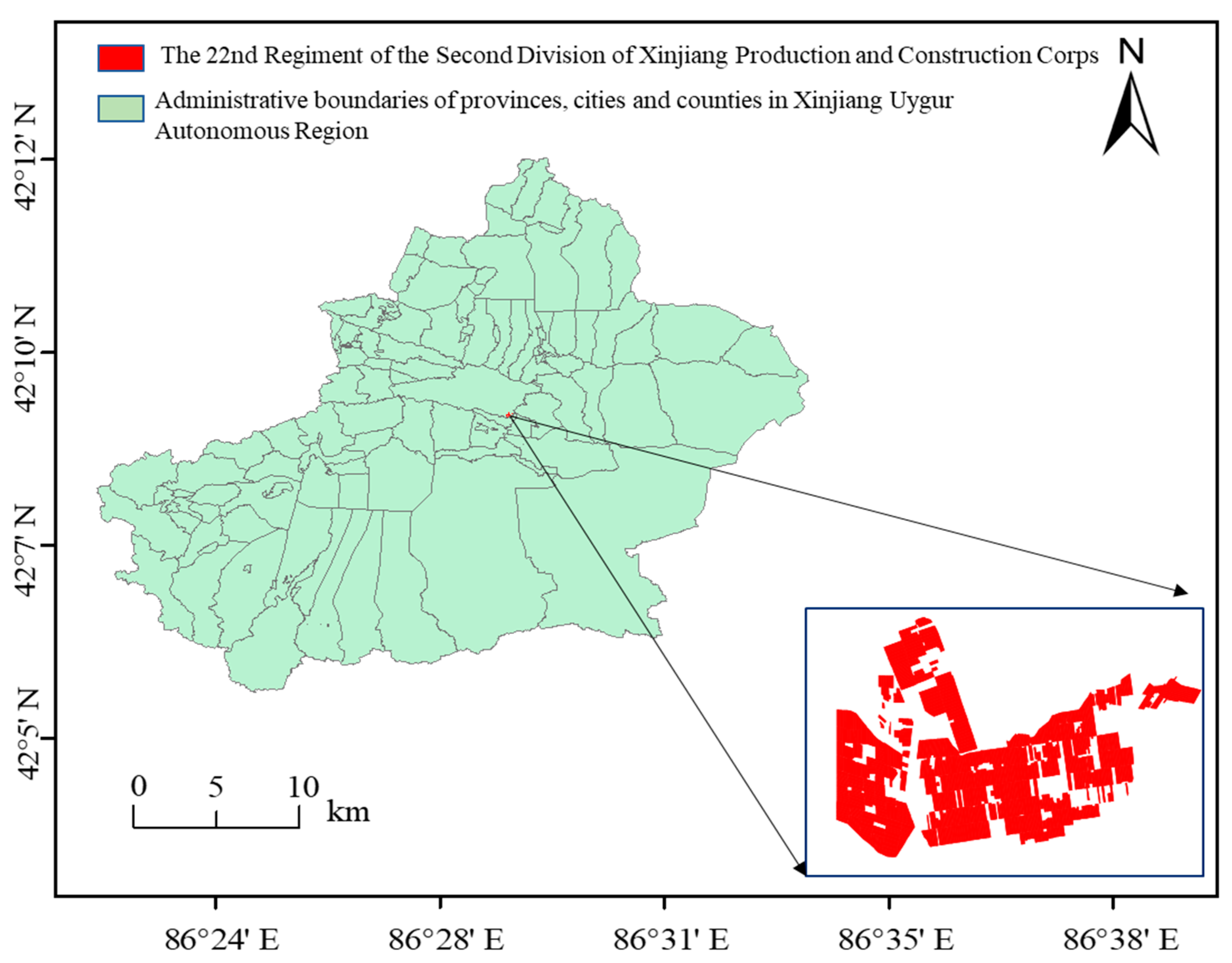
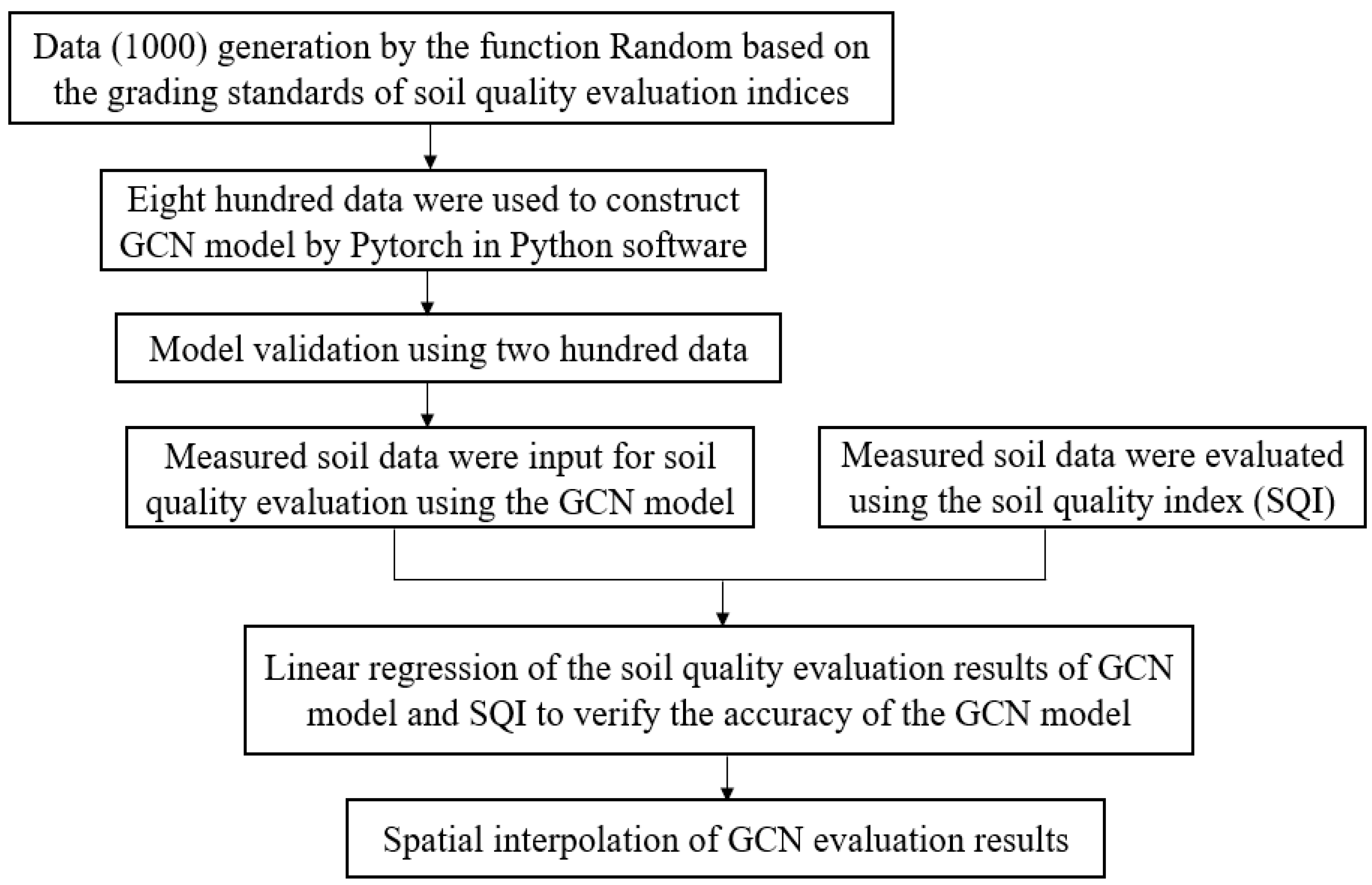

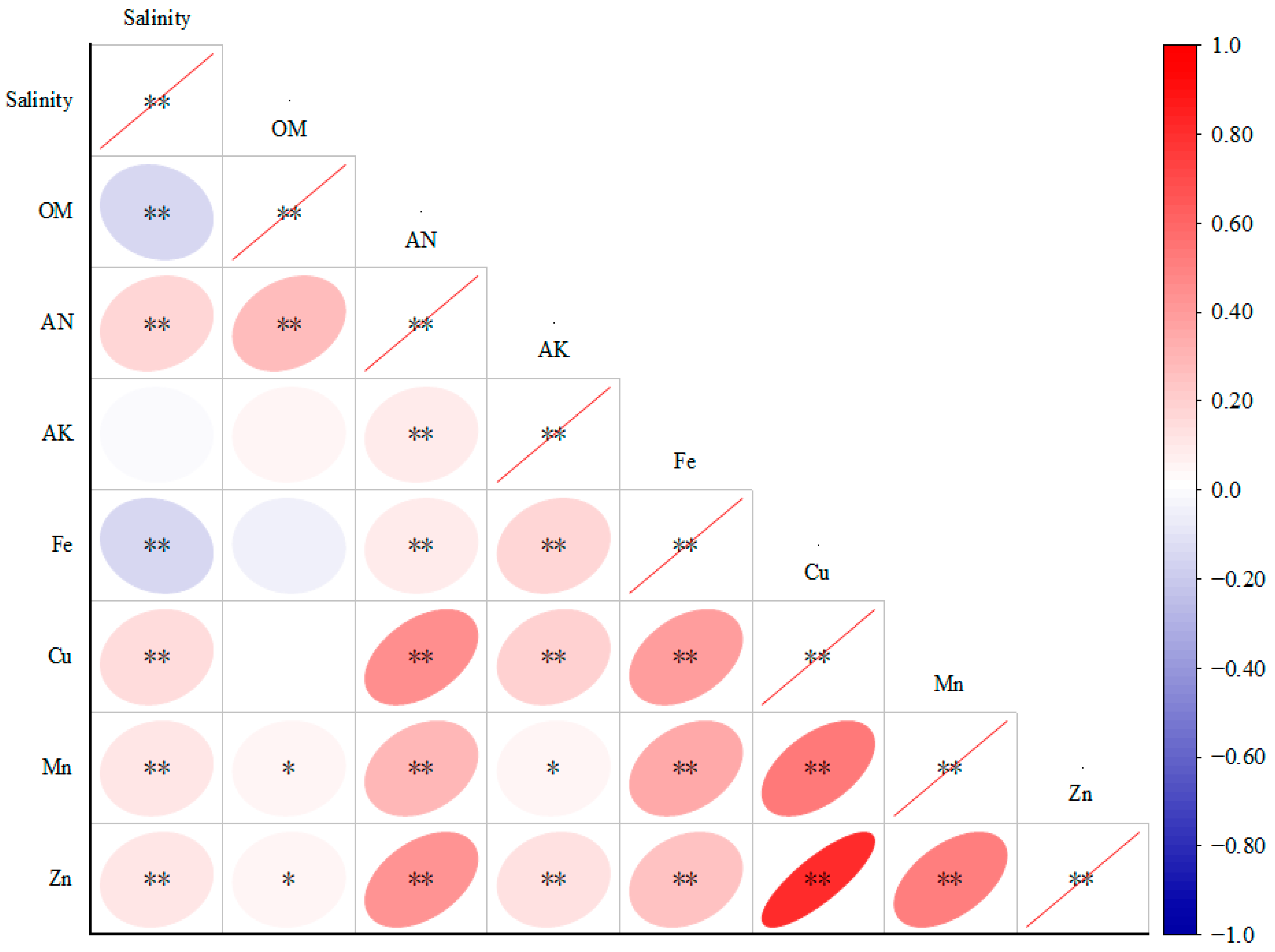
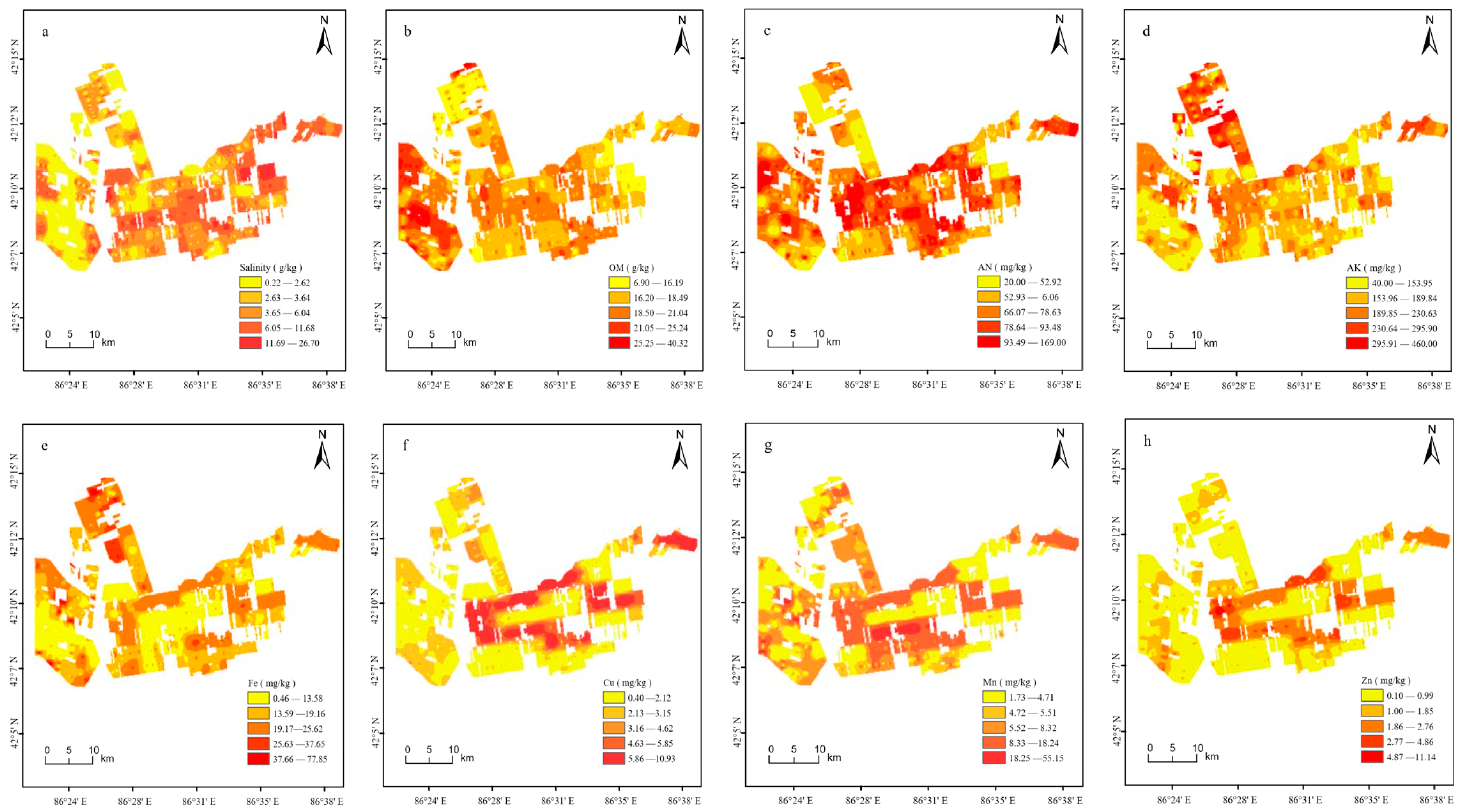
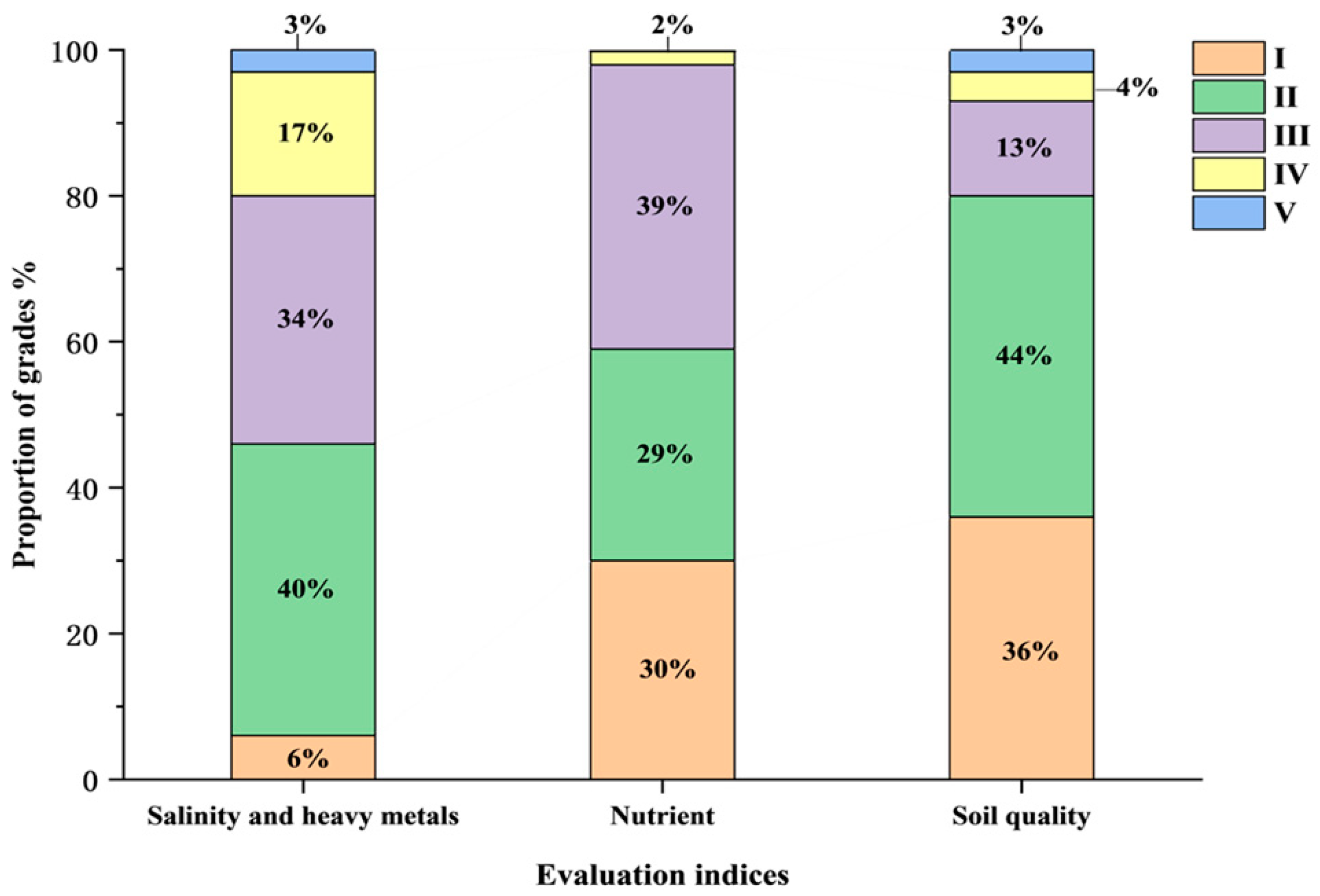


| Indices | I (Extremely Abundant) | II (Moderately Abundant) | III (Abundant) | IV (Medium) | V (Scarce) | VI (Extremely Scarce) |
|---|---|---|---|---|---|---|
| Organic matter (g/kg) | >40 | 30–40 | 20–30 | 10–20 | 6–10 | ≤6 |
| Available nitrogen (mg/kg) | >150 | 120–150 | 90–120 | 60–90 | 30–60 | ≤30 |
| Available potassium (mg/kg) | >200 | 150–200 | 100–150 | 50–100 | 30–50 | ≤30 |
| Indices | I (Extremely Abundant) | II (Abundant) | III (Medium) | IV (Scarce) | V (Extremely Scarce) |
|---|---|---|---|---|---|
| Iron (Fe) (mg/kg) | >20 | 10.0–20.0 | 4.5–10 | 2.5–4.5 | <2.5 |
| Copper (mg/kg) | >1.8 | 1.0–1.8 | 0.2–1.0 | 0.1–0.2 | <0.1 |
| Manganese (Mn) (mg/kg) | >30 | 15–30 | 5.0–15.0 | 1.0–5.0 | <1 |
| Zinc (Zn) (mg/kg) | >3.0 | 1.0–3.0 | 0.5–1.0 | 0.3–0.5 | <0.3 |
| Salinity (g/kg) | >13.45 | 8.66–13.45 | 7.27–8.66 | 5.54–7.27 | <5.54 |
| Indices | I (Extremely Abundant) | II (Abundant) | III (Medium) | IV (Scarce) | V (Extremely Scarce) |
|---|---|---|---|---|---|
| Organic matter (g/kg) | >30 | 20–30 | 10–20 | 6–10 | ≤6 |
| Available nitrogen (mg/kg) | >120 | 90–120 | 60–90 | 30–60 | ≤30 |
| Available potassium (mg/kg) | >150 | 100–150 | 50–100 | 30–50 | ≤30 |
| Iron (Fe) (mg/kg) | >20 | 10.0–20.0 | 4.5–10 | 2.5–4.5 | <2.5 |
| Copper (Cu) (mg/kg) | >1.8 | 1.0–1.8 | 0.2–1.0 | 0.1–0.2 | <0.1 |
| Manganese (Mn) (mg/kg) | >30 | 15–30 | 5.0–15.0 | 1.0–5.0 | <1 |
| Zinc (Zn) (mg/kg) | >3.0 | 1.0–3.0 | 0.5–1.0 | 0.3–0.5 | <0.3 |
| Salinity (g/kg) | >13.45 | 8.66–13.45 | 7.27–8.66 | 5.54–7.27 | <5.54 |
| Elements | Min | Max | Mean | SD | CV (%) | Kurtosis | Skewness | Background Value of Xinjiang |
|---|---|---|---|---|---|---|---|---|
| Salinity (g/kg) | 0.2 | 26.6 | 5.25 | 4.5 | 86 | 12.37 | 2.27 | |
| Organic matter (g/kg) | 7 | 40.3 | 18.59 | 3.71 | 20 | 0.52 | 1.09 | |
| Available nitrogen (mg/kg) | 20 | 169 | 72.86 | 23.99 | 33 | 4.29 | 0.54 | |
| Available potassium (mg/kg) | 40 | 460 | 188.78 | 70.81 | 38 | 0.33 | 0.62 | |
| Iron (Fe) (mg/kg) | 0.47 | 77.82 | 17.33 | 7.82 | 45 | 3.17 | 1.48 | 27.8 |
| Copper (Cu) (mg/kg) | 0.4 | 10.92 | 3.08 | 1.97 | 64 | 7.75 | 1.49 | 26.7 |
| Manganese (Mn) (mg/kg) | 1.74 | 55.1 | 7 | 5.53 | 79 | −0.58 | 1.01 | 688 |
| Zinc (Zn) (mg/kg) | 0.11 | 11.13 | 1.3 | 1.04 | 80 | 20.92 | 3.33 | 68.8 |
| Grade | Salinity (%) | Organic Matter (%) | Available Nitrogen (%) | Available Potassium (%) | Iron (%) | Copper (%) | Manganese (%) | Zinc (%) |
|---|---|---|---|---|---|---|---|---|
| I | 6.2% | 0.1% | 0.2% | 34.8% | 38.2% | 97.9% | 0.5% | 3.8% |
| II | 17.8% | 0.8% | 4% | 33.2% | 46.8% | 1.2% | 5.4% | 35.2% |
| III | 4.7% | 27.5% | 18.1% | 28.3% | 12.1% | 0.9% | 42.9% | 47% |
| IV | 7.4% | 69.2% | 45.8% | 3.5% | 1.6% | 0 | 51.2% | 11.0% |
| V | 63.9% | 2.4% | 30.2% | 0.2% | 1.3% | 0 | 0 | 3% |
| VI | 0 | 0 | 1.7% | 0 | 0 | 0 | 0 | 0 |
| Parameter | Range of Variation | Mean | Grade |
|---|---|---|---|
| Soil salinity/heavy metals | 0.38–0.94 | 0.78 | II |
| Soil nutrients | 0.02–0.68 | 0.35 | IV |
| Soil quality | 0.49–0.83 | 0.67 | II |
Disclaimer/Publisher’s Note: The statements, opinions and data contained in all publications are solely those of the individual author(s) and contributor(s) and not of MDPI and/or the editor(s). MDPI and/or the editor(s) disclaim responsibility for any injury to people or property resulting from any ideas, methods, instructions or products referred to in the content. |
© 2023 by the authors. Licensee MDPI, Basel, Switzerland. This article is an open access article distributed under the terms and conditions of the Creative Commons Attribution (CC BY) license (https://creativecommons.org/licenses/by/4.0/).
Share and Cite
Fan, X.; Gao, P.; Zuo, L.; Duan, L.; Cang, H.; Zhang, M.; Zhang, Q.; Zhang, Z.; Lv, X.; Zhang, L. Soil Quality Evaluation for Cotton Fields in Arid Region Based on Graph Convolution Network. Land 2023, 12, 1897. https://doi.org/10.3390/land12101897
Fan X, Gao P, Zuo L, Duan L, Cang H, Zhang M, Zhang Q, Zhang Z, Lv X, Zhang L. Soil Quality Evaluation for Cotton Fields in Arid Region Based on Graph Convolution Network. Land. 2023; 12(10):1897. https://doi.org/10.3390/land12101897
Chicago/Turabian StyleFan, Xianglong, Pan Gao, Li Zuo, Long Duan, Hao Cang, Mengli Zhang, Qiang Zhang, Ze Zhang, Xin Lv, and Lifu Zhang. 2023. "Soil Quality Evaluation for Cotton Fields in Arid Region Based on Graph Convolution Network" Land 12, no. 10: 1897. https://doi.org/10.3390/land12101897






